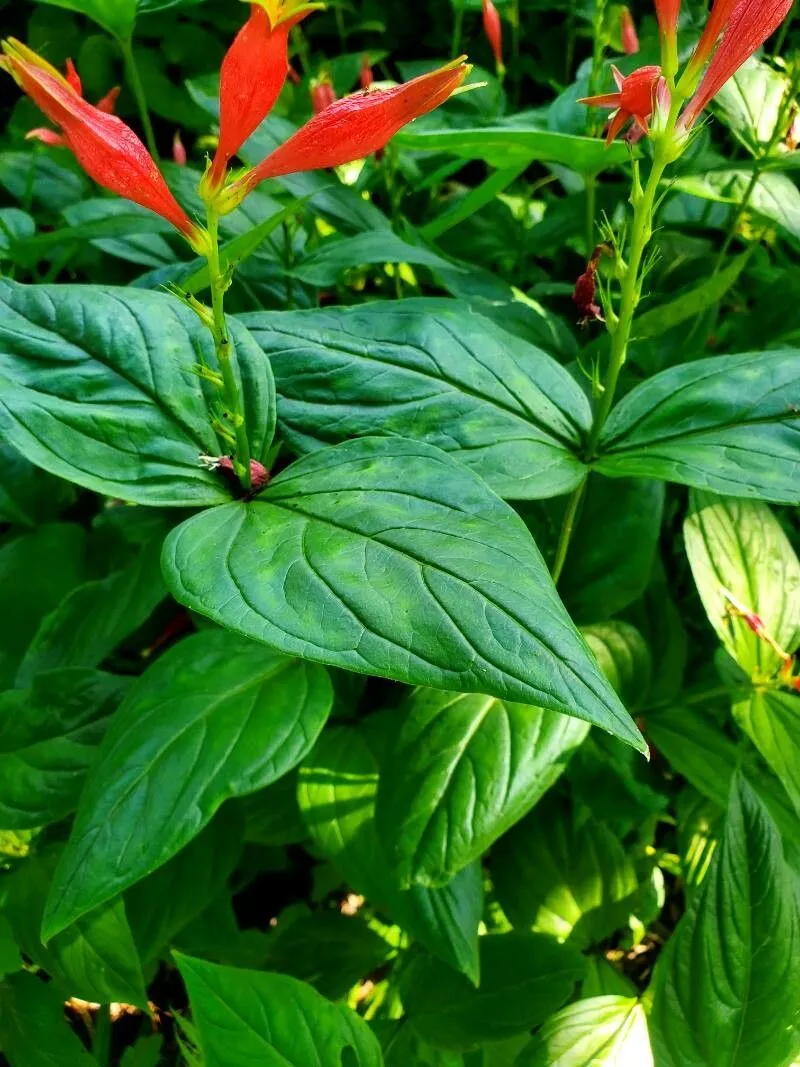
Author: (L.) L.
Bibliography: Syst. Nat. ed. 12, 2: 734 (1767)
Year: 1767
Status: accepted
Rank: species
Genus: Spigelia
Vegetable: False
Observations: EC. & SE. U.S.A.
Indian-pink, scientifically known as Spigelia marilandica, is a captivating perennial plant native to the eastern and southeastern regions of the United States. First documented in the 12th edition of Systema Naturae in 1767 by the renowned botanical author Carl Linnaeus, this striking species belongs to the Loganiaceae family.
One of the most recognizable characteristics of Indian-pink is its vibrant red tubular flowers with a striking yellow interior, which bloom from late spring to midsummer. These blossoms are not only visually appealing but also serve as a critical nectar source for hummingbirds, making this plant an excellent addition to wildlife-friendly gardens.
Indian-pink typically grows in clumps, reaching heights of up to 1 to 2 feet, and thrives in shaded or partially shaded environments. It prefers moist, well-drained soils rich in organic matter, though it can tolerate a range of soil types. The attractive, dark green, ovate leaves form a lush backdrop that enhances the beauty of the flowers.
Culturally significant for its medicinal properties, Spigelia marilandica was traditionally used by Native Americans for its therapeutic benefits. Despite its beauty and utility, it is essential to note that all parts of the plant are toxic if ingested, necessitating cautious handling.
In landscape design, Indian-pink is highly valued for its low-maintenance requirements and versatility. It works exceptionally well in woodland gardens, perennial borders, and naturalized areas where it can proliferate without overwhelming neighboring plants. Gardeners seeking to attract pollinators and add a splash of color to their shaded spaces will find Indian-pink to be a perfect choice.
Efforts to cultivate and conserve Spigelia marilandica should be emphasized, as this plant not only contributes to ecological diversity but also preserves a piece of botanical heritage with its rich historical and cultural legacy.
Eng: indian-pink, pinkroot, spigelia, woodland pinkroot
En: Indian-pink, Perennial worm grass, Woodland pinkroot, INDIANPINK, Pinkroot, Spigelia
Fi: Hurmepuuntojuuri
Ru: Спигелия мариландская
Taken Aug 6, 2020 by Diego Alex (cc-by-sa)
Taken Jun 18, 2022 by Sebra Debrecht (cc-by-sa)
Taken May 8, 2021 by Pinky Shalom (cc-by-sa)
Taken Jul 11, 2021 by Hendrik-Jan Hoogenberk (cc-by-sa)
Taken May 13, 2021 by Meg Mac (cc-by-sa)
Taken May 3, 2021 by Roxanna Stogner (cc-by-sa)
Taken Jun 18, 2022 by Sebra Debrecht (cc-by-sa)
Taken May 3, 2021 by Roxanna Stogner (cc-by-sa)
Taken Jun 5, 2021 by Dagmar Haggerty (cc-by-sa)
© copyright of the Board of Trustees of the Royal Botanic Gardens, Kew.
© copyright of the Board of Trustees of the Royal Botanic Gardens, Kew.
© copyright of the Board of Trustees of the Royal Botanic Gardens, Kew.
Growth habit>: Forb/herb
Family: Myrtaceae Author: (F.Muell.) K.D.Hill & L.A.S.Johnson Bibliography: Telopea 6: 402 (1995) Year: 1995 Status:…
Family: Rubiaceae Author: Pierre ex A.Froehner Bibliography: Notizbl. Bot. Gart. Berlin-Dahlem 1: 237 (1897) Year:…
Family: Sapindaceae Author: Koidz. Bibliography: J. Coll. Sci. Imp. Univ. Tokyo 32(1): 38 (1911) Year:…
Family: Asteraceae Author: A.Gray Bibliography: Pacif. Railr. Rep.: 107 (1857) Year: 1857 Status: accepted Rank:…
Family: Fabaceae Author: Medik. Bibliography: Vorles. Churpfälz. Phys.-Ökon. Ges. 2: 398 (1787) Year: 1787 Status:…
Family: Aspleniaceae Author: (Cav.) Alston Bibliography: Bull. Misc. Inform. Kew 1932: 309 (1932) Year: 1932…